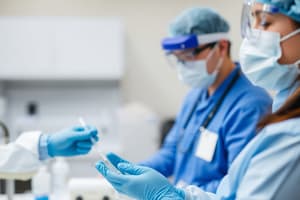Podcast
Questions and Answers
Match the specimen type with its collection method for abscess (pus):
Match the specimen type with its collection method for abscess (pus):
Purulent material = Aseptic collection with a sterile needle and syringe Miliary abscess = Open with a sterile scalpel and collect expressed material AFB culture = Transfer at least 1 ml of aspirated material into a sterile container Swabs = Not accepted for mycobacterial cultures
Match the specimen type with its optimal collection technique for bullae and vesicles:
Match the specimen type with its optimal collection technique for bullae and vesicles:
Fluid/purulent material = Aspirate using a sterile needle and syringe No material obtained = Unroof vesicle or bullous lesion and use Dacron swab Aspirate sample = Place in appropriate bacterial transport tube Dacron swab = Collect cells from the base of the lesion
Match the conditions with their specimen collection guidelines for cellulitis:
Match the conditions with their specimen collection guidelines for cellulitis:
Unusual organism suspected = Leading-edge punch biopsy is recommended Etiologic agents = Swabs and leading-edge aspirates fail to yield Biopsy specimen = Place in a sterile container with non-bacteriostatic saline Aspirate procedures = Should be conducted with or without saline injection
Match the type of wound with its specimen collection advice:
Match the type of wound with its specimen collection advice:
Match the recommendation with its related specimen type for complex wounds:
Match the recommendation with its related specimen type for complex wounds:
Match the collection method with the type of culture for abscesses:
Match the collection method with the type of culture for abscesses:
Match the statement with its applicable condition for specimen collection:
Match the statement with its applicable condition for specimen collection:
Match the collection procedure with the respective procedure for open wounds:
Match the collection procedure with the respective procedure for open wounds:
Flashcards
Abscess
Abscess
Collecting pus (purulent material) with a sterile needle and syringe from an undrained abscess.
Bullae/Vesicles
Bullae/Vesicles
Collecting fluid or pus from a blister with a sterile syringe. If empty, unroof the lesion and swab cells from the base.
Cellulitis
Cellulitis
Swabs and aspirates are often ineffective. For unusual organisms suspecting a leading-edge biopsy is preferred.
Sinus Tracts
Sinus Tracts
Signup and view all the flashcards
Open Wounds
Open Wounds
Signup and view all the flashcards
AFB Culture from Abscess
AFB Culture from Abscess
Signup and view all the flashcards
Swab Collection for Abscesses
Swab Collection for Abscesses
Signup and view all the flashcards
Gram Stain from Swab
Gram Stain from Swab
Signup and view all the flashcards
Study Notes
Specimen Collection for Microbiological Studies
-
Abscess (Pus):
- Decontaminate the surface with 70-95% alcohol and 1-2% iodine tincture.
- Collect pus aseptically from an undrained abscess using a sterile needle and syringe.
- Open miliary abscesses with a sterile scalpel, collecting expressed material with a sterile needle and syringe.
- Transfer 5-10 ml of the aspirated material to a sterile container.
- Transport immediately.
-
Bullae, Vesicles:
- Cleanse the skin as for blood cultures.
- Aspirate the fluid/pus using a sterile needle and syringe.
- If an aspirate is obtained, place in the appropriate bacterial transport tube or sterile container.
- If no material is obtained, unroof the vesicle/bulla and use a Dacron swab to collect cells from the base of the lesion.
- Place in appropriate bacterial transport media.
-
Cellulitis:
- Swabs and leading-edge aspirates often fail to yield etiologic agents.
- If an unusual organism is suspected, a leading-edge (advancing margin) punch biopsy is recommended.
- Place the biopsy specimen in a sterile container with a small volume of non-bacteriostatic saline.
-
Wounds (Closed):
- Refer to Abscess, Bullae, Cellulitis, and Vesicles protocols.
-
Wounds (Open):
- Clean the wound surface mechanically, removing superficial flora.
- Attempt to culture the base or edges to avoid "normal flora."
- Preferred specimens for sinus tracts:
- Aspirates of material obtained by needle or catheterization.
- Curettings from the sinus lining.
- Swabs are less preferred, unless aspirates/curettings are difficult to obtain.
- Swabs may not accurately reflect the underlying disease.
- Do not submit cultures of superficial lesions for anaerobic culture.
- Biopsy of the advancing wound margin is the preferred specimen for anaerobes, mycobacteria, and fungi.
-
Tissue:
- Tissue collection is an invasive procedure needing a trained physician.
- Collect tissue aseptically, including material from both the center and edge of the lesion.
- Place the specimen in a sterile container on sterile gauze moistened with sterile nonbacteriostatic saline.
- Transport within one hour at ambient temperature to preserve anaerobic organisms.
- Do not submit tissue in formalin.
- Do not use a swab to directly jam tissue into a Culturette.
-
General Notes:
- Anaerobic transport media are not suitable for AFB culture.
- At least 1 ml of aspirated material should be transferred to a sterile container for AFB cultures (to avoid drying).
- Swabs are generally not optimal for fungal, anaerobic, or mycobacterial cultures, or for perirectal/oral abscesses.
- Two swabs are needed for Gram stains.
Studying That Suits You
Use AI to generate personalized quizzes and flashcards to suit your learning preferences.



